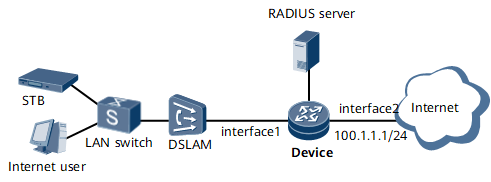Typical Single-Edge Network with Multicast Virtual Scheduling
In a typical single-edge network where a BRAS is accessed by users and forwards multicast traffic and multicast virtual scheduling is configured, the BRAS needs to provide both the functions of virtual scheduling and multicast data replication.
As shown in Figure 1, when getting online, the subscriber sends online request packets to NetEngine 8000 F. These request packets carry Option 82 information or outer VLAN information about the subscriber. NetEngine 8000 F identifies all the service flows belonging to the same family according to the Option 82 information or outer VLAN information, and implements scheduling of these services as a whole.
After detecting that the subscriber demands a multicast program and determining that virtual scheduling needs to be implemented, NetEngine 8000 F adjusts the bandwidth for the subscriber's unicast traffic based on the bandwidth of the demanded multicast program and the total bandwidth of the subscriber. Then, NetEngine 8000 F forwards the requested multicast traffic through the multicast VLAN, and the downstream device (for example, the DSLAM) copies the multicast traffic to the subscriber.
